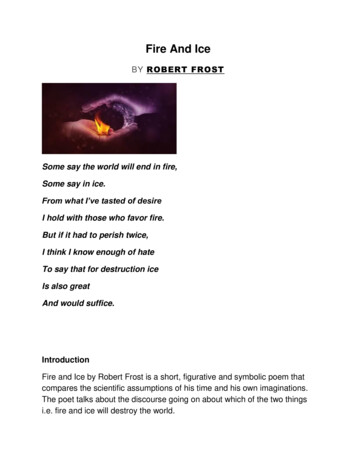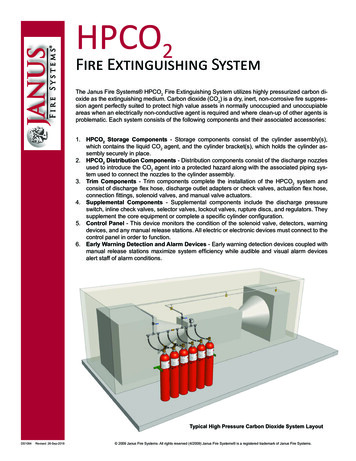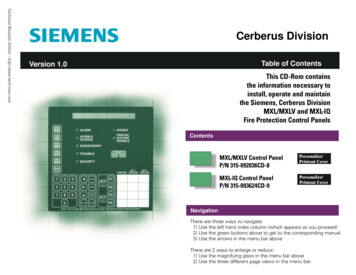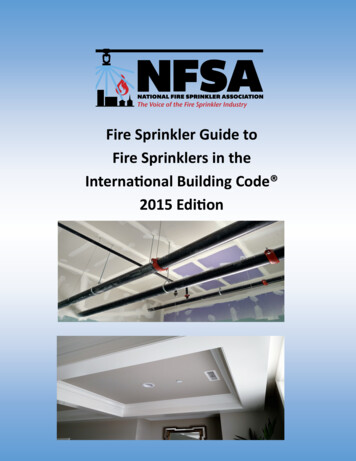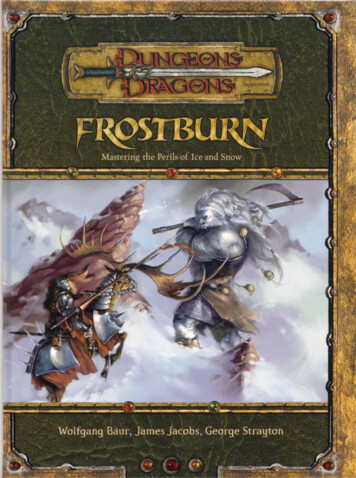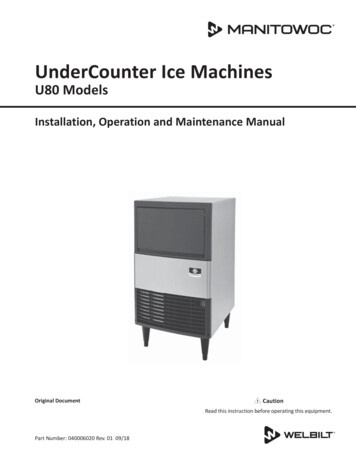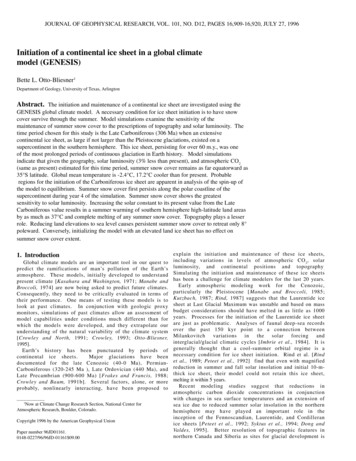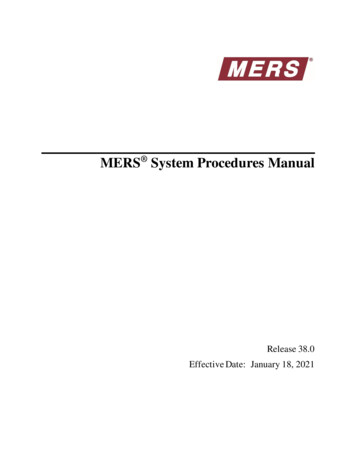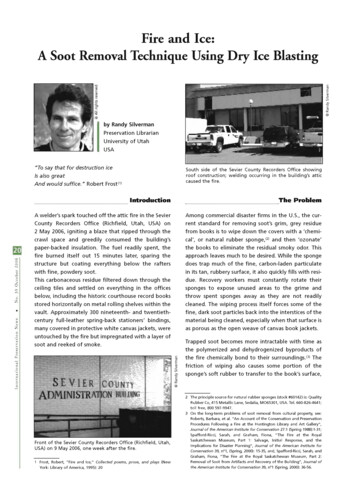
Transcription
Fire a n d Ice:Randy SilvermanA S o o t R em oval Technique U sin g D r y Ice B lastin gby Randy SilvermanPreservation LibrarianUniversity of UtahUSA"To s a y t h a t fo r d e s tr u c tio n iceSouth side o f the Sevier County Recorders Office showingro o f construction; w elding occurring in th e building's atticcaused the fire.Is also g r e a tA n d w o u ld s u ffic e ." R obert Frost(1)In tro d u c tio nA m ong com mercial disaster firms in t h e U.S., t h e cur County Recorders Office (Richfield, Utah, USA) onre n t s ta n d a r d fo r rem oving soot's grim, grey residue2 May 2006, igniting a blaze t h a t ripped t h r o u g h t h efrom books is t o w ip e d o w n t h e covers w ith a 'chem i crawl space a n d greedily c o n s u m ed t h e building'scal', or n atu ra l r u b b e r sponge, a n d t h e n 'o z o n a te 'p a p e r-b a ck ed insulation. The fuel readily spent, t h et h e books t o elim ina te t h e residual sm oky odor. Thisfire b u r n e d itself o u t 15 m inutes later, sparing t h eapproach leaves much t o be desired. While t h e sp o n g estru ctu re b u t c o a tin g everything belo w t h e raftersd o es t r a p much of t h e fine, c a rb o n -la d en p articulatew ith fine, po w d ery soot.in its ta n , rub bery surface, it also quickly fills w ith resi This c a rb o n a c e o u s residue filtered d o w n t h r o u g h t h edue. Recovery w orkers must constantly r o ta t e th e irsp o n g e s t o expose unu se d areas t o t h e grim e andbelow, including t h e historic c o u r th o u s e record bookst h r o w sp e n t sp o n g e s aw ay as th e y are n o t readilysto red horizontally on m etal rolling shelves w ithin t h ecleaned. The w iping process itself forces som e of t h efine, dark so o t particles back into t h e interstices of t h e ceiling tiles a n d se ttle d on everything in t h e officesvault. A pproxim ately 300 n in e te e n th - a n d tw e n t ie t h -Inuernauional Preservation NewsNo. 39 October 2006A w elder's spark to u c h e d off t h e attic fire in t h e SevierT h e P ro b le mcentury fu ll-leather spring-back sta tio n e rs ' bindings,material being cleaned, especially w h e n t h a t surface ism any covered in protective w h ite canvas jackets, w e reas porous as t h e o p e n w e a v e of canvas b o o k jackets.u n to u c h e d by t h e fire b u t im p r e g n a te d w ith a layer ofso o t a n d ree k ed of smoke.T rapped so o t becom es m o re intra cta b le w ith tim e ast h e polym erized a n d d e h y d ro g e n iz e d byproducts oft h e fire chemically b o n d t o th e ir su rro u n d in g s.(3) Thefriction of w iping also causes so m e p o rtion of t h espo n g e 's soft r u b b e r to tr a n s f e r t o t h e book's surface,Front o f the Sevier County Recorders O ffice (Richfield, Utah,USA) on 9 May 2006, one week after the fire.1 Frost, Robert, "Fire and Ice," Collected poems, prose, and plays (NewYork: Library of America, 1995): 20The principle source for natural rubber sponges (stock #60142) is: QualityRubber Co, 415 Metallic Lane, Sedalia, M065301, USA. Tel. 660-826-4641;toll free, 800 597-9947.On the long-term problems of soot removal from cultural property, see:Roberts, Barbara, et al. "An Account of the Conservation and PreservationProcedures Following a Fire at the Huntington Library and Art Gallery",Journal of the American Institute for Conservation 27:1 (Spring 1988):1-31;Spafford-Ricci, Sarah, and Graham, Fiona, "The Fire at the RoyalSaskatchewan Museum, Part 1: Salvage, Initial Response, and theImplications for Disaster Planning", Journal of the American Institute forConservation 39, n 1, (Spring, 2000): 15-35, and, Spafford-Ricci, Sarah, andGraham, Fiona, "The Fire at the Royal Saskatchewan Museum, Part 2:Removal of Soot from Artifacts and Recovery of the Building", Journal ofthe American Institute for Conservation 39, n 1 (Spring, 2000): 36-56.
tr a d in g o n e u n sta b le residue for a n o t h e r .(4) Finally,exposing 'cle an e d ' books t o o z o n e t o red uc e t h e resi dual sm o k e o d o r causes f u r th e r d e g r a d a tio n . A strongoxidizer, o z o n e aggressively breaks d o w n paper, cloth,leather, a n d adhesives w hile it d ec o m p o se s t h e o r g a nic c o m p o n e n ts of t h e sm o k e - a highly undesirablet r a d e o f f fo r books of historic significance m a n d a te dby law to be m a in ta in e d in perpetuity.In short, s o o t is an extrem ely te n a c io u s m aterial toremove. Unlike dust, it is a solid/liquid residue c o m p o sed of ca rb o n su sp e n d e d in an oily f o u n d a ti o n of p a r tially c o n s u m ed com b u stio n byproducts. The carb onw ithin t h e s e t a r d roplets is so fine - 1 m in diam eter,or appro x im ate ly 1/50 t h e w id th of a h u m a n hair - itis readily dispersed by t h e "pressure a n d buoyancyc re a te d by t h e h e a t of t h e fire" a n d aero d y n am icconditions such as "stack effect, w ind pressures, t h ebuilding g e o m e tr y a n d its barriers (such as walls andfloors), a n d v en tilation practices."(5) Soot's fine p o w d e r coats every expo sed surface, p e n e tr a ti n g even t h etiniest crevices an d crannies, a n c horing t h e carbonw ith oily ta rs w h e r e it lands. Removal a t te m p ts bywiping, even w ith an ab s o rb e n t, fleshy m aterial suchas t h e a b o v e - m e n tio n e d natural r u b b e r sp o n g e , inevi tab ly sm ears w h a te v e r so o t do es n o t b o n d t o t h esp o n g e , com pressing a n d e m b e d d in g t h e dim inutive,An in te rio r office w ith evidence o f smoke damage on thewalls.t h e m m o re difficult t o rem ove. As s o o t ages, it ch em i Eliminating residual sm o k e o d o r from objects follo cally cross-links t o t h e material it is in c o n tac t with,w in g so o t removal is t h e nex t th o r n y p roblem . In a d d i making im m ediate cleanup t h e optimal course of choice.tio n t o simply spraying scents t o mask t h e odor, at p re it is actually less effective t h a n w iping w ith an a b s o r b e n t m aterial. In t h e 1997 S ask a tch e w an (Canada)M useum fire, fo r exam ple, Spafford-Ricci a n d G ra hamre p o r t t h e s o o t rem oval protocol used fo r b o o k clea ning included an initial vacu u m in g of t h e book's bin recovery industry: chemical d e o do riz ing, th e rm a l d e o dorizing, a n d o z o n e tr e a t m e n t . U nfortunately, all t e r in t a n d e m w ith m a n u al w ipin g can help, b u t alo n esent, t h r e e a p p ro a c h e s p r e d o m i n a te w ith in t h e firet h r e e have serious d raw backs w h e n dealing w ith cul tural h e r ita g e material.Chemical deo d o riz in g elim inates odors t h r o u g h a c h e mical reaction occurring w h e n t h e chemical fu m es ofding, f o llo w ed by a s e p a r a t e v ac u u m in g of t h e te x tt h e p ro d u c t co m e into c o n ta c t w ith sm o k e residue.block. Care w as ta k e n n o t t o to u c h t h e surface of t h eThese d eo d o riz ers co m e in a w id e ra n g e of extrem elybooks w ith t h e vacuum 's nozzle as this c o n ta c t w o u ldp u n g e n t fragran ces desig n ed t o 'purify' air spaces ran push s o o t into t h e w o v e n fabric o f t h e b ookb indings.ging in size fro m 1,000-20,000 cubic feet. Some ofA fter vacuu m ing, t h e second p h a s e of this cle a n u pth e s e f o rm u latio n s a re applied as a th e rm a l fog;included mechanically w ipin g t h e book's surface w itho th e rs a re simply diffused from t h e source container.r u b b e r s p o n g e s o r Webril W ipes (a felted , n o n w o v e nThe lon g -te rm effects on cultural pro p erty of th e s e100% c o t to n pad c o m m only used in t h e printingp roprie ta ry f o rm u latio n s have n o t b e e n analyzed.in d u stryM o re broadly, how ever, d e l e te r i o u s effec ts fro mfornon-abrasivec le a n in gofp r in tin gplates).(6)g aseo u s p o llu tan ts - particularly su lphur dioxide (S02),oxides of n itro g e n (NOx), a n d o z o n e ( 0 3) - have bee nwell d o c u m e n te d w ith paper, leather, textiles, dyes,4 See: Moffatt, E., "Analysis of 'chemical sponges' used by the commercial firecleanup industry to remove soot from various surfaces", IIC-CG(International Institute for Conservation - Canadian Group) 17/3 (1991): 9-10.5 McKinnon, Gordon P. and Keith Tower (eds.), Fire protection handbook,14thed. (Boston: National Fire Protection Association, 1976): 2-19; 2-27.6 Spafford-Ricci, Sarah and Graham, Fiona, "The Fire at the RoyalSaskatchewan Museum, Part 2: 48-49.Inrernarional Preservarion NewsV acuum ing w ith a high efficiency particle (HEPA) fil No. 39 Occober 2006greasy specks f u r th e r into t h e surface a n d making
Randy Silvermanpigm ents, inks, adhesives, a n d p h o to g r a p h ic film.(7 Introduction of gaseo u s chemicals fo r d e o doriz ingpurposes is n o t re c o m m e n d e d until th e ir lo ng-termeffects can be te ste d .Thermal o xidation deo d o riz in g is a second a p p ro a chused t o e lim ina te volatile organic c o m p o u n d s (VOCs)fro m t h e a m b ie n t air. Essentially, t h e system is ana f te r b u r n e r t h a t draw s w o rkplac e air t h r o u g h a co m b u s tio nc h a m b e r w h e r e VOCs a r eincinerated. *Principally used in industrial setting s t o deal w ithgaseo u s by products from petrochemicals, printing,paint, fo o d , s e w a g e an d w a ste t r e a tm e n t, applicationRecord book storage vault w ith metal roller shelving; a te m porary positive air v e n tila tio n system is set up to help w ithsoot extraction.of this te c h n o lo g y to redu c e sm o ke odors e m a n a tin gfro m h e r ita g e m aterials has n o t yet, t o my k now led g e ,t h e material can be well exp osed t o t h e air flow. Anb e e n a t te m p te d .inexpensive altern ativ e is to place small a m o u n ts ofm aterial in relatively airtig h t enclosures (such as aFinally, o z o n e is com m only used t o t r e a t sm o k e odorslarge, sealed plastic g a r b a g e bag) in close proximity t oin a ffec ted ho u se h o ld a n d office objects. This t r e a t l a rg e q u a n t itie s of e x p o s e dm e n t includes cre atin g copious a m o u n ts of 0 3 w ith ana p p r o a c h may t a k e t w o t o t h r e e m o n th s to w o rk w ithelectric o z o n e g e n e r a t o r an d se q u e ste rin g t h e sm oke-t h e key being t o ex p o su re t h e im p a cted material tod a m a g e d m aterial in a con fined space w ith t h e gas.th eU nfortunately, w hile 0 3 elim inates sm o k e odors, in"Records which survived t h e 1906 San Francisco fireabsorbentm e d ia.b a k in g so d a .M ichaelTrinkleyEitherrep o rts:high c o nc entra tions, 0 3 is b o th harm ful t o h u m a na n d a re to d a y in t h e [U.S.] National Archives still smellhealth an d an aggressive oxidizer k now n t o d e l e t e strongly of sm o k e - over 90 years latter.";(l1) a c ondi riously im pact a w id e r a n g e of cultural h e r ita g e m a t e tio n possibly e x a c e rb a te d by t h e lack of air exchange.rials, as n o te d a b o v e .(10) Hence, desp ite its c o m m o n useNo. 39 October 200623for less significant objects, 0 3should be avoided.At present, t h e only safe a p p r o a c h to rem oving sm okeodors from cultural m aterial is t o isolate t h e sm oketa in te d objects in a room w ith an o p e r a tin g air purifi cation system t h a t contains activated carbon, zeolite,a n d /o r potassium p e r m a n g a n a t e filtration. C on tin u ously re-circulating filtered air past t h e objects willInuernauional Preservation NewsS e v ie r C o u n tyreduc e sm oke's lingering o d o r gradually over tim e ifIn t h e a fte rm a th of t h e Sevier County Recorders Officefire, a n o n -d am a g in g alternative t o t h e current clea ning options s e em e d desirable. Invited by t h e responsi ble commercial recovery com pany t o serve as a consul ta n t , 03 I sug g e sted dry ice blasting as an interestingpossibility. Dry ice blasting has proven its utility in avariety of industrial applications over t h e past d ec ad eincluding dispatching paint from decorative metalwork;7 Committee on Preservation of Historical Records, National MaterialsAdvisory Board, Preservation of historical records (Washington, D.C.:National Academy Press, 1986): 11-31; Baer, Norbert S., and Banks, Paul,"Indoor air pollution: Effects on cultural and historic materials",Internationaljournal of museum management curatorship 4 (1985): 9-20.8 Thermal Oxidation Deodorizing Machine, by Osaka Gas EngineeringCo., LTD, recovered from the world wide web 25 May 2006: http://www.gecj p/CTT DATA/AIR/AIR 5/html/Air-159.html 9 U.S. Environmental Protection Agency, "Ozone Generators that are Soldas Air Cleaners: An Assessment of Effectiveness and HealthConsequences", recovered from the world wide web 25 May 2006: http://www.epa.gov/iaq/pubs/ozonegen.html ; U.S. EnvironmentalProtection Agency, air quality criteria for ozone and other photochemi cal oxidants, EPA-600/8-78-004 (Research Triangel Park, North Carolina:U.S. Environmental Protection Agency, 1978).10 Bogarty, H., Campbell, K. S., and Appel, W. D., "The oxidation ofcellulose by ozone in small concentrations", Textile research journal22 (1952): 81-83; Cass, Glen R., Druzik, James R., Grosjean, Daniel,Nazaroff, William W., Whitmore, Paul M., and Whittman, Cynthia L.Protection of Works of Art From Atmospheric Ozone, (Los Angeles:The Getty Conservation Institute, 1989). Full text available at: http://www.getty.edu/conservation/publications/pdf publications/alpha author.html ; Salvin, V. S., "Ozone fading of dyes," Textile chemistand colorist 1 (1969): 245-251. Shaver, C. L., Cass, Glen R., and Druzik,James R., "Ozone and the deterioration of works of art," Environmentalscience &technology 17 (1983): 748-752.cleaning dirt from brick, granite, marble, onyx, or o th e rsto n e materials; stripping built-up w e t or dry ink fromprinting presses; removing fused dust from electricalturbines, g e n e r a to r windings, an d transformers; andr e m e d ia t in gm oldfro mbu ildingin te rio rs.03'Additionally, t h e system is p o rtab le an d can be p o w eredby an electric g enerator, add in g significantly t o itsmerits since t h e County Recorder w ou ld n o t perm it t h ed a m a g e d books t o leave t h e Recorders Office.The process w orks by shaving solid blocks of dry ice11 [Trinkley, Michael], Chicora Foundation, "Fire" [ca. 16 June 2003],recovered from the world wide web 24 May 2006: http://www.chico ra.org/fire.htm 12 Utah Disaster Kleenup (13081 South Minuteman Drive, Draper, Utah84020 USA; tel. (801) 553-1010; http://www.utdk.com/index.php ) isthe commercial firm responsible for this recovery.13 C02LDSWEEP Dry Ice Blasting, brochure (n.p; n.d, c. 2006).
(frozen C 0 2) into g ranules ranging in size fro m t h ed ia m e t e r of su g a r t o t h e s h a p e of rice, d e p e n d in gu p o n t h e application. These g ranules are p rop elled ina co m pressed air strea m of 30-300 PSI a g a in st t h e sur face t o be cleaned. Dry ice blasting is considered co m pletely non-abrasive w h e n used on surfaces h a rd e rt h a n fro z en C 0 2, b u t can be used t o 'a n ti q u e ' w o o d e nsiding by differentially a b r a d in g t h e softer, pithyw o o d an d leaving t h e grain. Frozen C 0 2 pellets e m e r g efrom t h e nozzle a t -78 C, dramatically low ering t h esurface t e m p e r a t u r e of t h e m edia being c lea n ed andcausing increm ental shrinkage. This con tra ctio n occurssim ultaneously as t h e C 0 2 sublim ates t o its gas phase,e x p a n d in g appro x im ate ly 80-800 tim es its originalsize. These m ultiple forces - con tra ctio n d u e t o cold,tu r b u le n c e caused by rapid sublim ation, a n d pressurefrom t h e compressed airstream - occur simultaneously.As t h e m in u te dry ice particles p e n e t r a t e t h e intersti ces of t h e m edia being cleaned , t h e C 0 2 sublim atesleaving only 'dirt' as t h e residual byproduct.As a p r e p a ra to ry ste p t o a t te m p tin g t o rem o ve t h eso o t fro m Sevier County's record books using dry iceblasting, a co uple of e x p e n d a b le m o d e rn publishers'bindings w e r e first te s te d . W ith t h e dry ice crystalst h e books t o p re v e n t abrasion (15-18 inches), a localNo. 39 Occober 2006a n d t h e com pressed air nozzle held far e n o u g h fromFirst test sample; a late tw e n tie th century publishers' bin ding. Dry ice blasting adequately cleaned surface grim e but ifthe focus o f the blast was prolonged, gold stamping and pig m ent fro m the publishers' cloth were removed.a p p lic a to r04* expertly c lea n ed th e s e mock ups w hile Im o n it o r e d t h e effect. T he a p p lic a to r played t h em achine's05' spray of C 0 2 g ranule s in a steady sw ee pacross t h e bindings, his experience essential t o p r e v entin g d a m a g e . The te c h n iq u e w o rk e d flawlessly, b u tw e also discovered t h a t t o o long a focus on o n e spot, or allow ing t o o little distance b e t w e e n t h e nozzle andbook's surface, could rem ove dye from t h e cloth orgold foil sta m p in g fro m t h e cover. W e also f o u n d t h a tolder, h a n d to o lin g (bo th h a n d sta m p in g a n d d e c o r a tive lines run w ith a roll) p re s e n te d no p ro b lem in t h ecleaning, sugg e stin g t h a t m o d e rn titling on mass m a r k et books is f a r m o re friable t h a n earlier han d w o rk .Similarly, directing t h e dry ice nozzle directly a t t h ee d g e s of t h e te x t could a b r a d e t h e p a p e r surface sligh Second test sample; cleaning results from a lig h tly soot dama ge 20th century record book covered in a protective w h itecanvas jacket. The area o f the jacket le ft o f the number '73'and below the word 'Deed' was vacuumed w ith a HEPA vac;and, the area above the words 'Deed Record' was ry ice blasted.tly, so t h e situatio n w as re m e d ie d by focusing t h enozzle's aim specifically at t h e b o a rd e d g e so only t h eperip heral dry ice spray played over t h e fo re -e d g e,h ea d , a n d tail. By firmly clam ping t h e te x t closed and14 This experimental work was conducted by Randell Heath, President,C02LDSWEEP Dry Ice Blasting (3612 Quail Point Road, Mountain Green,UT84050 USA; tel. 801-876-5432; info@coldsweep.com ). Mr. Heath isa certified mechanical engineer, and coincidentally, was originally bornin Sevier County, UT. He served as a subcontractor to Utah DisasterKleenup at the rate of US 150.00 per hour.15 The dry ice blasting machine used was the Alpheus Precision Series TMModel T-2. This machine is quite mobile, measuring 14 in. x 22 in x 20 in(35,56 cm. x 55,88 cm. x 50,80 cm.; Wx Lx H) and weighing 110 lbs. (50kg). It stores 12 lbs. (5.4 kg) of block dry ice, and produces a blast pres sure range of 30 psi - 120 psi (2.1 bar - 8.3 bar).minimizing direct pressure t o t h e p a p e r e d g e s t h e te x tw as u n d a m a g e d by t h e cleaning process.W e t h e n c o m p a r e d dry ice blasting w ith t w o o th e rform s of s o o t removal using actual record books;w iping d o w n p a r t of a b o o k w ith a natural r u b b e rsp o n g e , a n d v acuum ing a n o t h e r section w ith a HEPAfilter. As described earlier, t h e r u b b e r s p o n g e provedInrernarional Preservarion Newsg r o u n d sugar-fine, t h e PSI set t o a m inim um (30 PSI),
reasonably effective a l th o u g h it left so m e visible so o tresidue. The HEPA-vacuuming p roved f a r less effectivet h a n t h e sp o n g e , underscoring t h e b o n d in g stre n g thof t h e soot, even a single w e e k a f te r t h e fire. Dry iceblasting p ro v e d t h e m ost effective o f t h e t h r e em e th o d s an d caused no d e te c ta b l e abrasion. In a d d i tio n t o rem oving t h e soot, t h e cleaning elim inatedyears of e m b e d d e d h a n d gre a se as well as a piece ofpressure sensitive t a p e a lo n g w ith t h e discoloredadhesive residue b e n e a t h it. As a f u r th e r test, eachc leaned ob ject w as s e q u e s te r e d o v e rn ig h t in a sealedbox t o d e t e r m in e h o w much residual sm oke o d o rAn eighteenth century fu ll-lea ther record book sitting on theAlpheus Precision Series TM Model T-2 dry ice blasting machi ne as it is refilled w ith block dry ice.rem a in ed . Again, dry ice blasting surpassed t h e t w oo th e r cleaning m e thod s.The t e c h n iq u e also p roved t o b e f a r f a s te r t h a nw ip ing d o w n t h e boo ks using r u b b e r sp onges. Thecanvas-covered bindings t o o k lo n g e r t o clean t h a nbooks w ith exp o sed leather, b u t on a v e rag e, six booksw e r e dry ice blasted p e r h o u r (50 hours total). Ja yre neNielsen, t h e County Clerk, expressed h e r a m a z e m e n ta t t h e e n d result. She claim ed t h e boo ks h ad n ev erlooked so clean. W hile building repairs progressed ,t h e com m ercial recovery com pany, leery of a slightresidual sm o k e odor, p a c k a g e d t h e cle a n e d volum esf o r s to r a g e in boxes c o n ta in in g a chemical d e o d o r i zer. In direct discussion a b o u t this w ith t h e CountyClerk, Ms. Nielsen a g r e e d t o rem o v e t h e d eo d o riz e rsf ro m t h e boxes, claim ing she actually p r e fe rre d t h esmell of sm o k e t o t h e noxious d e o d o r a n t! She alsobelieved t h e sm o k e o d o r w as rapidly dissipating ast h e books aired out.As w ith any n e w c onservation te c h n iq u e , dry ice blas tin g will surely prove t o have its limitations. Based ont h e excellent results a t Sevier County, how ever, ita p p e a r s t h e te c h n iq u e has g r e a t prom ise fo r a d d r e s sing certain p ro blem s a n d sho uld b e con sid ered as aviable o p tio n as t h e situ atio n d e m a n d s. Additionally,Randell Heath, President, C02LDSWEEP Dry Ice Blasting, atw o rk removing soot from a Sevier County record book.f u r th e r sa fe g u a r d s or m odification s t o t h e a p p r o a c hd e s c rib e dh e r e in m ay b e w a r r a n t e d .G re a t cares ho uld be exercised, fo r exam ple, w h e n te s tin g dry iceblasting's effectiveness fo r rem ov ing s o o t fro m rarebooks, as t h e a g e a n d variability of t h e m aterial invol ved m ig h t well p r e s e n t n u m e ro u s challenges. W hiledry ice blasting has b e e n successfully used fo r moldre m e d ia tio n on building surfaces, its ap p lica tio n t orem oving m old fro m d a m a g e d bind ings has yet t o beinvestigated. Again, dry ice blasting seem s t o o ffe rmuch promise, a n d ad d itio n a l re p o rts a n d te s tin g ari sing fro m f u t u r e a pplica tions of t h e te c h n o lo g y areencouraged.Before and after, "Fee Entry Book M ", the to p half o f thebook cleaned by dry ice blasting, the bo tto m half still cove red in soot.
U so d e h ie lo s e c o p a r a r e m o v e r e l h o llmEl 2 d e mayo d e 2006, en el Servicio de archivistas del C o n d a d o d e Sevier (Richfield, Utah, EE.UU.), se d e s a t6 unincendio en un g ra n e ro ocasion ado por un chispazo de un soldador. El com bustible se a g o t o r a p id a m en te, porlo q u e el f u e g o se extinguio quince m inutos mas ta r d e sin causar d an o s a la estructura, p ero c u brie nd o to d ocon una fina capa d e hollm, q u e d a n d o afectados los registros hist6ricos q u e contem'an los Archivos del Palaciod e Justicia, 300 e n c u ad e rn a cio n es en piel d e los siglos XIX y XX.El hollm es una m ateria e x t r e m a d a m e n te pegajosa q u e g e n e r a lm e n te se elimina m e d ia n te esponjas d e caucho.Este proce d im ie n to rela tiv a m en te eficaz requiere, no o b sta n te , renovar con m ucha frecuencia las esponjas q u ese llenan d e residuos. Presenta, adem as, el inconveniente d e acu m ular el hollm e n tre los intersticios del d ocu m e n to q u e se esta limpiando. O tra tecnica consiste en utilizar un filtro de partlculas HEPA, pero usada sola, estaresulta m ucho m enos eficaz.El s e g u n d o p ro blem a tie n e q u e ver con el olor residual del h u m o q u e se elimina m e d ia n te el uso d e desodorantes quimicos o te rm icos y d e t r a t a m ie n to s con ozono. En los dos primeros casos, los efectos a largo plazo deestos productos aim no han sido probados, por lo q u e no se reco m ien da su utilizacion. En lo q u e respecta alozono, se t r a t a de un ox id a n te agresivo q u e tie n e efectos nocivos para los d o c u m e n to s q u e f o rm a n p a r te delp atrim onio cultural. Ademas, es nocivo para la salud. Para eliminar el olor, la unica tecnica segura, p o r lo ta n to ,Despues del incendio del Servicio d e archivistas del C o n d a d o de Sevier, se o p to p o r u n a alternativ a sin riesgo encom paraci6n con las opciones habituales d e limpieza. El m 6 to d o seleccionado, cuya eficacia ha sido d e m o strad aen num erosas aplicaciones i n d u s t r ia ls d u r a n te la ultima decada, consistio en pulverizar hielo seco carbonicoa e s ta d o gaseoso en el m o m e n to en q u e p e n e tr a n en los intersticios del soporte, p ro d u cie n d o com o derivado residual u n ic a m e n te sal.Inrernarional Preservarion Newsso b re las obras. Los g ranulos de C 0 2 co n g e la d o s son proyectados sobre la superficie q u e se va a limpiar y pasanNo. 39 Occober 2006consiste en aislar los d o c u m e n to s afectados en una sala e q u ip a d a con un sistema d e purificacion d e aire.Una e t a p a p rep a ra to ria consiste en hacer p ru eb a s en encu ad e rn a cio n es m o d e rn a s d e poco valor. Este procedi m ie n to luego se co m p a ro con los m to d o s q u e en los q u e se utiliza una esponja y/o un filtro HEPA, d e m o s tr a n d oser m ucho mas eficaz. Esta tecnica no s o la m e n te no es abrasiva, sino q u e p erm ite eliminar las traz as de seboincrustadas anos atras. Ha perm itido t r a t a r seis libros por hora. E videntem ente, este p rocedim ien to es n uevo yd e b e utilizarse con precaucion, ya q u e su aplicacion e n c u ad e rn a cio n es d a n a d a s se e n c u e n tra aim en estudio.Sin em b a rg o , luce pro m etedor.
L e fe u et la g la c e : p u lv eriser d e la g la ce sech ec a r b o n iq u e p o u r e lim in e r la su iep a r Randy SilvermanSi la surface b r u n e e t c a o u tc h o u te u s e d e I'e p o n g e per-Responsable d e la conservationm e t d 'e n le v e r u n e g r a n d e p artie d e s fines particulesUniversite d e I'Utah - USAch a rg ees d e c h a rb o n , elle se c h a rg e aussi r a p id e m e n td e residus. Les p erso n n e s responsables des r ep a ra tio n sd o iv e n t c o n s ta m m e n t c h a n g e r d 'e p o n g e p o u r net-« P o u r d ir e q u e , p o u r la d e s tr u c tio n , la g la c eto y e r les salissures avec u n e surface p r o p re e t j e te r lesE st e g a le m e n t fa b u le u s ee p o n g e s u sa g ee s parce q u ’elles p e u v e n t difficilementE t s e r a it e ffic a c e .»§ tre n e tto y e e s. Le processus m e m e d e n e t t o y a g e faitq u e q u e lq u e s-u n e s des fines particules d e suie noire- Robert Frostso n t repoussees dan s les interstices du d o c u m e n t net-In tro d u c tio ntoye, particu lie rem e n t q u a n d c e tte surface est aussip o re u se q u e le tissag e a d e c o u v e r t des ja q u e t t e s enLe 2 mai 2006, dan s le Service des Archivistes du Com ted e Sevier (Richfield, Utah. USA), le feu se d e d e n c h a aug ren ie r a cause d e I’etincelle d 'u n e soudeuse, provoq u a n t u n e explosion qui souffla le vide d e com ble etc on sum a a t o u t e vitesse le system e d'isolation en fibred e verre e t rec ouvert d e papier. Le co m bustible flit viteepuise e t le fe u m o u r u t 15 m inu tes plus ta rd , eparg n a n t la stru ctu re mais rec o u v ra n t t o u t sous les c h e No. 39 Ocrober 2006vrons d 'u n e fine e t p o u d r e u s e pellicule d e suieCe residu c h a r b o n n e u x p n e tra e n tre les tuiles e trecouvrit t o u t dans les b u re a u x qui se t r o u v a i e n t au dessous, y compris les registres historiques c o n t e n a n tles archives du Palais de Justice, stockees a I'horizontalesur des ra y o n n a g e s coulissants, dan s la c h a m b r e fo rte.Environ 300 reliures piein cuir d a t a n t des xixc e t xx‘siecles, d o n t plusieurs e t a i e n t rec o u v ertes d e j a q u e tt e sInrernarional Preservarion Newsen toile blanche, f u re n t e p a r g n e e s par le feu maistoile.Plus le te m p s passe e t plus il est difficile d e retirer lasuie incrustee dan s la m e su re o u les derives polymeri ses e t d e h y d ro g e n s du f e u se fixent c h im iq u e m e n tsur leur e n v i ro n n e m e n t . 3) Le f r o t t e m e n t q u e Ton prod uit en n e t t o y a n t fait aussi q u e des m orce aux d e lap artie en c a o u tc h o u c s o u p le d e I 'e p o n g e m ig re n t surla surface du livre, un residu instable e n rem p laq an t una u t r e . Enfin, le fait d 'ex p o se r a I’o z o n e des livres« n e tto y e s » p o u r a t t e n u e r I'o deur residuelle d e fu m e eles d e t rio re d a v a n ta g e . L'ozone est un oxy d an t puis s a n t qui a t t a q u e le papier, le tissu, le cuir e t les a d h e sifs e n m d m e te m p s qu'il d e tru it les co m p o sa n ts organiques d e la fu m e e , c o n tre p a r tie p articu lie rem e n tn e fa ste p o u r des ouv rag e s ay a n t u n e im p o rta n c e histo r iq u e considerab le e t d o n t la loi stipule qu'ils doi vent e tre conserves p o u r P eternite.im p re g n e e s d 'u n e couche d e suie e t d 'u n e fo rte o d e u rd e fum ee.En bref, la suie est u n e m a t u r e e x t rd m e m e n t te n ac e.C o n tra ir e m e n t a la poussiere, c'est un residu la foissolide e t liquide, c o m p o se d e c h a rb o n en suspensionL e p ro b le m ed an s u n e b ase huileuse de derives d e com b u stio n enpartie consumes. Le charbon a I'interieur de ces g o u tte -D'ordinaire, les
the fire chemically bond to their surroundings.(3) The friction of wiping also causes some portion of the sponge's soft rubber to transfer to the book's surface, 1 Frost, Robert, "Fire and Ice," Collected poems, prose, and plays (New York: Library of America, 1995): 20 The principle sou
